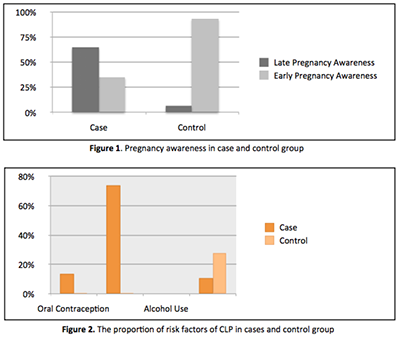Pregnancy Unawareness and Risk Factors in Cleft
DOI:
https://doi.org/10.14228/jpr.v2i2.151Abstract
Background : The etiology of the cleft lip and palate (CLP) are still debated among researchers. Early pregnancy awareness is essential since the facial formation occurs in the first eight-week of gestation period. This study aims to compare pregnancy awareness and risk factors associated with CLP.
Method : A descriptive cross-sectional study on 103 mothers whose child suffered from non-syndromic CLP (cases) was compared to 157 mothers whose child is normal (control). Parameters evaluated were pregnancy awareness during early pregnancy and CLP risk factors, including oral contraceptive (OC), absence of vitamin supplementation, smoking, and alcohol use within the first eight-week of gestation period. Family history and maternal age were also assesed.
Result : The rates of late pregnancy awareness were 10-folds higher in cases, with the scale of 65% compared to 6.5% (p value <0.0001). The use of OC in cases group were 22.6-folds higher (13.6% versus 0.6%), the absence of vitamin supplementation were found to be 123-folds higher as well (73.8% compared to 0.6%). An inverted data were found in the smoke exposure parameter, which was higher in control (27.7% versus 10.7%). In confounded factors, advanced maternal age in the cases soared (37.9% compared to 25.3%), positive family history of cleft were discovered in 24.3% of mother with cleft children.
Conclusion : Most cases were categorized in late pregnancy awareness. Higher rates of positive family history and advanced maternal age in cases group were also found.

Downloads
Published
Issue
Section
License

This work is licensed under a Creative Commons Attribution-NonCommercial-NoDerivatives 4.0 International License.
Authors retain the copyright of the article and grant Jurnal Plastik Rekonstruksi the right of first publication with the work simultaneously licensed under a Creative Commons Attribution License. Articles opting for open access will be immediately available and permanently free for everyone to read, download and share from the time of publication. All open access articles are published under the terms of the Creative Commons Attribution-Non-commercial-NoDerivatives (CC BY-NC-ND) which allows readers to disseminate and reuse the article, as well as share and reuse of the scientific material. It does not permit commercial exploitation or the creation of derivative works without specific permission.













